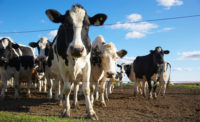The Innovation Center for U.S. Dairy launched three resources designed to help the dairy value
chain measure, improve and communicate about sustainability.
Since the launch of the U.S. Dairy Sustainability Commitment in 2008, the Innovation Center for U.S. Dairy - established under the leadership of America’s dairy producers - has united the dairy value chain in a collective effort to measure and improve the environmental, social and economic sustainability of U.S. dairy from farm to table.
Using a research-based approach, the Innovation Center is establishing benchmark measures of industry-level dairy sustainability, while putting tools in the hands of decision-makers to drive innovation at individual businesses.
That’s why the Rosemont, Ill.-based organization launched three resources designed to help the dairy value chain measure, improve and communicate about sustainability.
For starters, the 2011 U.S. Dairy Sustainability Report provides an update on progress toward the industry’s sustainability goals. Two measurement web resources - Dairy Plant SmartandDairy Fleet Smart - provide milk processors and transporters with the tools to calculate their carbon footprints and identify opportunities to save energy and money.
In addition, www.USDairy.com/Sustainability provides access to more decision-making tools such as the SaveEnergy resource, which connects dairy farmers with financial assistance opportunities for farm energy audits and equipment upgrades.
“We’ve spent three years in the field gathering research to support our science- and practice-based approach to improving sustainability across the value chain - from growing crops to feed our dairy cows, to processing and manufacturing real, fresh, nutrient-rich dairy foods and beverages through consumption and packaging disposal,” says Barbara O’Brien, president of the Innovation Center for U.S. Dairy. “The key learning we identified about dairy’s impacts and opportunities for improvement made these new resources possible.”
The 2011 U.S. Dairy Sustainability Report serves as a comprehensive resource on dairy sustainability for the dairy industry, as well as its partners and consumers. It expands beyond the greenhouse gas (GHG) emissions and fluid milk focus of the 2010 report to include broader discussions on the environmental, social and economic aspects of U.S. dairy.
Highlights of the 2011 industry-wide efforts include:
• Engaging more than 830 stakeholders who invested approximately 6,700 working days, valued at more than $6.2 million, to support dairy sustainability efforts throughout the year.
• Launching a new industry-wide initiative to establish the sustainability measurement and reporting framework for U.S. dairy.
• Partnering with stakeholders in the inaugural U.S. Dairy Sustainability Awards program, which recognizes efforts that deliver outstanding benefit to business, community and the environment.
“Sustainability has become a key business strategy for the industry and its future development,” O’Brien says. “In addition to industry-level work, the Innovation Center built upon the findings of the GHG Life Cycle Assessment for Fluid Milk to develop and test a suite of measurement tools. These tools help dairy farms and businesses adopt sustainable practices that improve their environmental performance and positively impact their bottom line.”
Dairy Plant Smartenables fluid milk processing plants to evaluate overall energy use - including production, transport, refrigerant losses and packaging - to identify opportunities to conserve energy use. In addition to reducing GHG emissions and lowering utility bills, energy efficient practices can help milk processing plants improve system reliability, prevent maintenance and shutdown costs, increase productivity and introduce new revenue streams.
Meanwhile,Dairy Fleet Smart helps transportation managers identify ways to more efficiently deliver milk from the production facility to storage or retail by completing a 360-degree evaluation of fuel used. Adopting fuel-efficient best practices can save trucking companies a substantial amount in fuel costs, while also reducing emissions.
TheDairy Plant Smart and Dairy Fleet Smart tools feature case studies highlighting proven best practices and the associated cost and energy savings. The respective calculator tools also allow dairy plants and transport fleets to benchmark their energy efficiency performance against the U.S. average to identify areas for greatest improvement. As part of the U.S. Dairy Sustainability Commitment,Dairy Plant SmartandDairy Fleet Smartaim to help the industry achieve a combined reduction of 705,457 metric tons of emissions and $108 million in annual business savings toward the voluntary industry-wide reduction goal.
“Resources likeDairy Plant Smart, Dairy Fleet Smart and the 2011 U.S. Dairy Sustainability Report provide verified information, common measures and best practices to help producers, processors, manufacturers, transporters and brands improve their economic, social and environmental sustainability,” says Jed Davis, director of sustainability at Cabot Creamery Cooperative, Montpelier, Vt.
Get our new eMagazine delivered to your inbox every month.
Stay in the know on the latest food and beverage manufacturing markets.
SUBSCRIBE TODAYCopyright ©2024. All Rights Reserved BNP Media.
Design, CMS, Hosting & Web Development :: ePublishing


